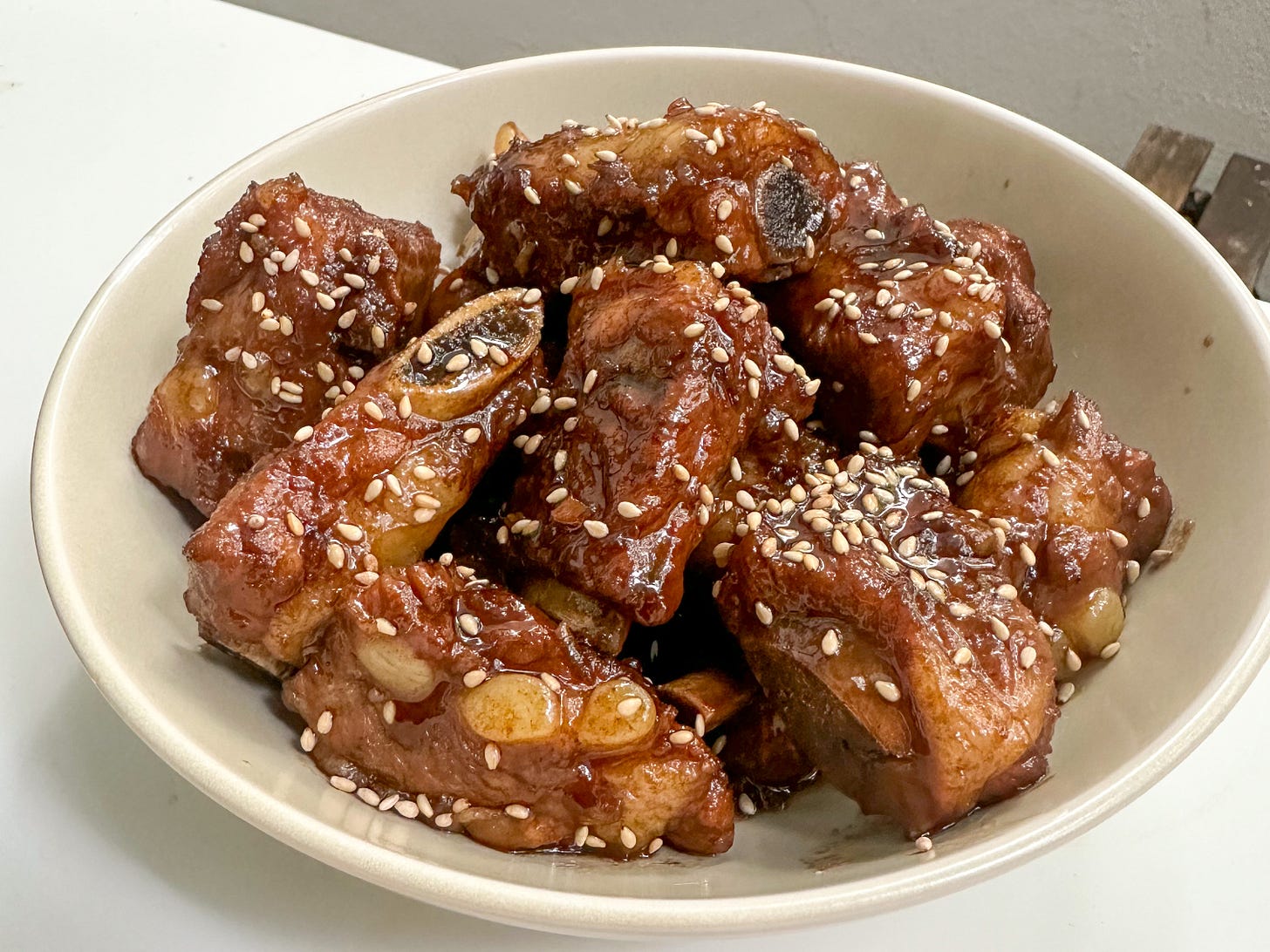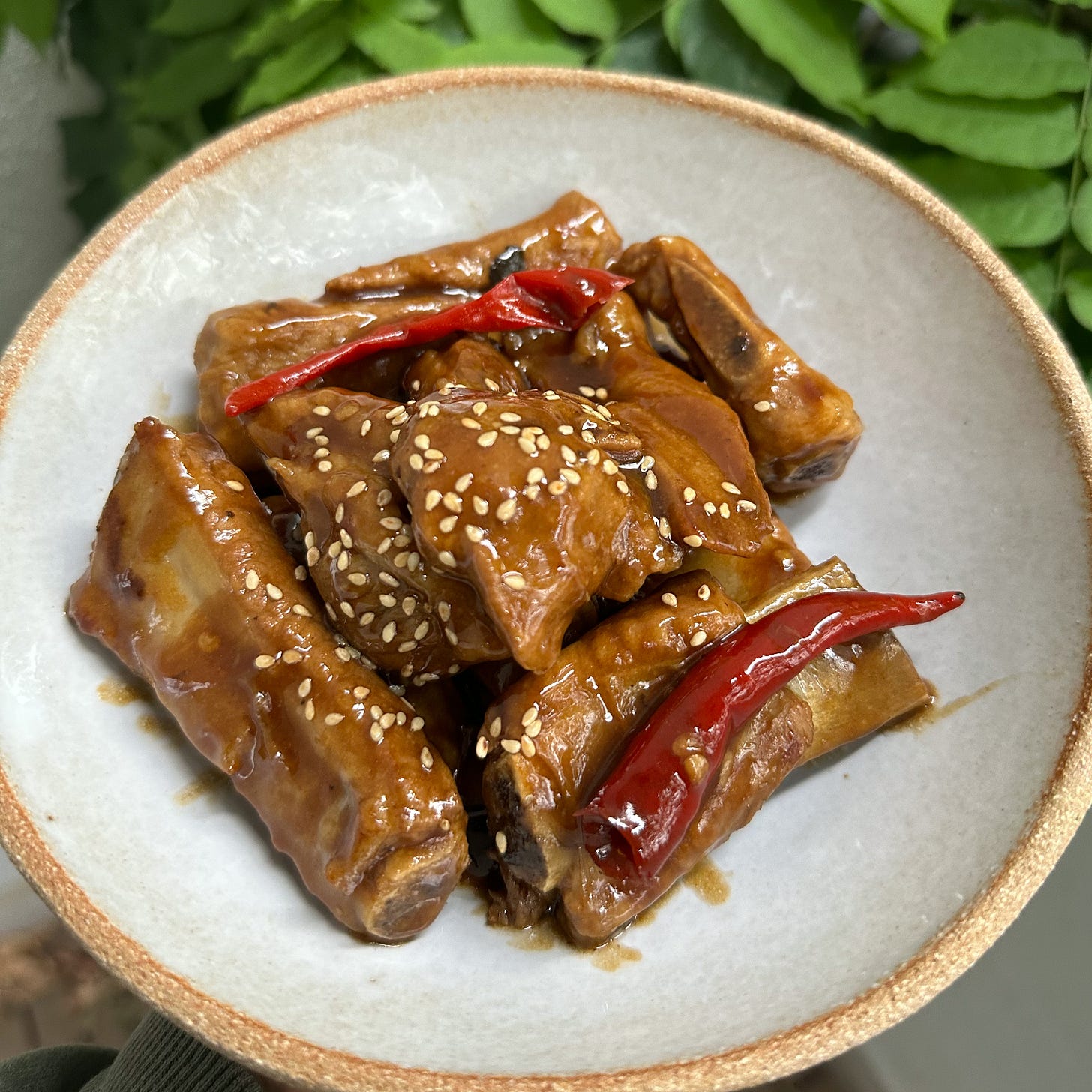Happy weekend! This week marks the conclusion of our series of recipes focusing on black vinegar. You can find the deep dive in this condiment, an easy pickle and fish-fragrant eggplants.
Few dishes make black vinegar shine like a plate of Tangcu Paigu (糖醋排骨): braised pork ribs in a caramel sweet-sour glaze. This dish is one of the most beloved Chinese meat dishes, with regional variations found in Sichuan, Canton, and areas around Shanghai1. The Cantonese version resembles the classic sweet and sour pork often found in takeouts, with a tanginess from pineapple and ketchup; while in Sichuan, they’re made with vinegar and rock sugar, often served as a cold appetizer.
Upon reflecting on my taste memory and browsing through recipes and videos, I've realized that the regional differences are becoming less distinct, resulting in a more consistent dish in recent years. Nowadays you’d also find creative variations made with citrus fruits, hua mei (dried Chinese plums), and passion fruit to partially substitute the sourness, and honey or coke for sweetness.
In restaurant versions, the ribs are typically fried or steamed before being coated in a glossy sauce, a technique known as zha shou (炸收, fried and reduced). I first learned this easy home version years ago from the internet while living in a student dorm in Berlin, which only involves a simple shallow-fry and braise technique. I would prepare it whenever cravings struck or when I needed to bring a dish to a potluck (which was always a hit). Last year, I tried a version from an old Sichuan cookbook I acquired; however, the addition of chili and starch didn’t quite match the flavor profile of tangcu paigu as I remembered it.
In the video, I talked about the dilemma of translating this dish as "sweet and sour". Many people associate this term with Cantonese takeout, which is not entirely inaccurate, as there are variations of northern Tangcu pork (which influenced Chinese-Korean Tangsuyuk). Yet, having a menu full of sweet and sour dishes may overlook the beautiful and subtle differences in these flavor combinations. Perhaps "Tangcu ribs" could be a better option, as we have retained "Kung Pao" and "Fish-fragrant" to indicate various shades of sweet and sour.
In Fuschia Dunlop’s new book Invitation to a Banquet, she dedicates an essay to sweet and sour flavors and the complex yet nuanced balance of Chinese cuisine: “For Sichuan’s, China’s greatest modern masters of the art of blending tastes, sweet-sour is just one of a wide repertoire of complex, many-layered flavors or fuhe wei.” She notes, “Yet sweet-and-sour food has never been as popular among Chinese people as it is among western consumers of Chinese cuisine. Sweet-sour dishes are eaten in China, but not as frequently and generally as just one style among many.”
The recipe
Servings: 2
Ingredients
500g pork ribs (spareribs or baby back ribs)
40g rock sugar or white sugar
1 tbsp Shaoxing wine
2 tbsp light soy sauce
1/2 tbsp dark soy sauce
3 tbsp Chinese black vinegar (2 for the braise and 1 to add at the end)
4 slices ginger
2 scallions, made into a knot
about 300-500ml hot water, enough to cover the ribs
toasted white sesame seeds
lime or lemon juice (optional)
approx 2 tbsp vegetable oil
Instructions
Cut the ribs along the bone, into smaller pieces. Soak the ribs in cold water for 30 minutes - 1 hour, rinse thoroughly, and dry completely. Alternatively, you can blanch the ribs by placing them in cold water, bringing to a boil, simmering for 10 minutes, and then draining.
In a wok or big pot, heat vegetable oil. Fry the ribs in a single layer until both sides turn golden brown. Once the color changes, push the ribs to the side. Add rock sugar to the middle of the wok and heat until it melts into a light golden caramel, using a spatula to break it into smaller pieces. Mix the ribs with the sugar caramel until well-coated.
Deglaze the wok with Shaoxing wine. Add light and dark soy sauce, most of the black vinegar, ginger and scallion. Cover with hot water, bring to a simmer, and then cover with a lid. Let it stew over medium-low heat for approximately 45 minutes to 1 hour, until the ribs are tender and the sauce has reduced.
Remove the lid, increase the heat, and let the sauce reduce to a thick gloss. Remove the ginger and spices, and add the remaining vinegar. Serve the ribs with a splash of lime or lemon juice, and garnish with toasted white sesame seeds. Serve warm or lukewarm with rice.
Tips for making best tangcu paigu
Choice of vinegar: I use a combination of Shanxi mature vinegar and Chinkiang vinegar (added at the end), as the Shanxi variation retains its tang even after braising, while Chinkiang adds aroma to the dish. However, you can use either type of black vinegar or Baoning.
Adding vinegar twice: The first time is to season the sauce and tenderize the meat. As vinegar loses its flavor when heated, the last splash helps refresh that tang.
Choice of ribs: I chose boxed spare ribs from local grocery stores, but you can also use baby back ribs. This dish typically looks best when the ribs are chopped into smaller pieces, so you can ask the butcher or use a cleaver to chop them smaller. However, I don’t mind them being a bit bigger and inconsistent in my dish.
Caramelizing sugar: This step, called chao tangse (炒糖色), is common in braised dishes. Many recipes call for it at the very beginning, but if you don’t get the temperature right, it might burn and turn bitter. I prefer to add it after the ribs are fried golden, which avoids splattering as well. This also shortens the braising time for the pork. Rock sugar gives the sauce a nice gloss, but caster sugar works fine too.
Some book state that the Sichuan version also includes Sichuan pepper, while the Shanghai-style Tangcu Paigu incorporates ketchup. Additionally, the Zhejiang version involves frying the battered ribs twice and coating them in a starchy sauce. Others argue that in Sichuan, Shanghai, and Beijing areas, the emphasis is more on the vinegar, whereas in Suzhou and Wuxi, the focus is on the sugar. Generally, sweet and sour fish dishes are often cooked with a sauce made from tomato sauce or ketchup, known as qie zhi (茄汁), to achieve a nice deep red color.






